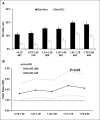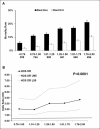Relative hyperlactatemia and hospital mortality in critically ill patients: a retrospective multi-centre study
- PMID: 20181242
- PMCID: PMC2875540
- DOI: 10.1186/cc8888
Relative hyperlactatemia and hospital mortality in critically ill patients: a retrospective multi-centre study
Abstract
Introduction: Higher lactate concentrations within the normal reference range (relative hyperlactatemia) are not considered clinically significant. We tested the hypothesis that relative hyperlactatemia is independently associated with an increased risk of hospital death.
Methods: This observational study examined a prospectively obtained intensive care database of 7,155 consecutive critically ill patients admitted to the Intensive Care Units (ICUs) of four Australian university hospitals. We assessed the relationship between ICU admission lactate, maximal lactate and time-weighted lactate levels and hospital outcome in all patients and also in those patients whose lactate concentrations (admission n = 3,964, maximal n = 2,511, and time-weighted n = 4,584) were under 2 mmol.L-1 (i.e. relative hyperlactatemia).
Results: We obtained 172,723 lactate measurements. Higher admission and time-weightedlactate concentration within the reference range was independently associated with increased hospital mortality (admission odds ratio (OR) 2.1, 95% confidence interval (CI) 1.3 to 3.5, P = 0.01; time-weighted OR 3.7, 95% CI 1.9 to 7.00, P < 0.0001). This significant association was first detectable at lactate concentrations > 0.75 mmol.L-1. Furthermore, in patients whose lactate ever exceeded 2 mmol.L-1, higher time-weighted lactate remained strongly associated with higher hospital mortality (OR 4.8, 95% CI 1.8 to 12.4, P < 0.001).
Conclusions: In critically ill patients, relative hyperlactataemia is independently associated with increased hospital mortality. Blood lactate concentrations > 0.75 mmol.L-1 can be used by clinicians to identify patients at higher risk of death. The current reference range for lactate in the critically ill may need to be re-assessed.
Figures



Comment in
-
Hyperlactatemia in critical illness and cardiac surgery.Crit Care. 2010;14(3):421. doi: 10.1186/cc9017. Epub 2010 Jun 3. Crit Care. 2010. PMID: 20529384 Free PMC article. No abstract available.
References
-
- De Backer D. Lactic acidosis. Intensive Care Med. 2003;29:699–702. - PubMed
-
- De Backer D. Lactic acidosis. Minerva Anestesiol. 2003;69:281–284. - PubMed
-
- Vincent JL, Dufaye P, Berre J, Leeman M, Degaute JP, Kahn RJ. Serial lactate determinations during circulatory shock. Crit Care Med. 1983;11:449–451. - PubMed
Publication types
MeSH terms
Substances
LinkOut - more resources
Full Text Sources
Other Literature Sources
Medical

